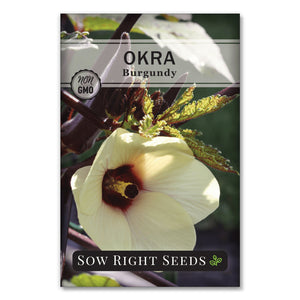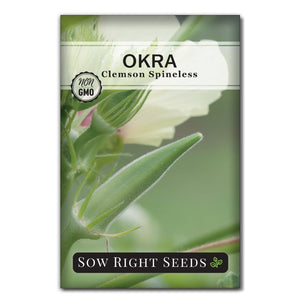How to Grow Okra That's Tender and Tasty for All Your Favorite Recipes
OkraOkra is an easy plant for first-time gardeners in warm climates. It loves the summer sun and will have a reliable production of edible seedpods. The secret to tender and tasty okra is knowing when to plant and when to harvest. If you’re interested in growing this delicious and beautiful vegetable, we’ve got the growing tips you need for a successful harvest.

Okra (Abelmoschus esculentus) is a fast-growing, heat-loving plant. While typically grown for its plentiful production of seedpods, okra also has beautiful flowers. Both the okra seedpods and flowers are edible, but the seedpods are the main focus for vegetable gardeners.
Typically okra plants grow 3 to 5 feet high. But in some locations, they easily grow 6 and 8 feet high. They produce pale yellow blooms that look like hibiscus flowers. Okra, hibiscus, rose mallow, and many other plants all belong to the mallow family and have similar flowers.
The seedpods develop as the flowers fall off. Most pods are green, but there are burgundy-colored varieties as well.
When to Plant Okra
Planting okra at the right time means planting in the right conditions. Okra should be planted in the spring and summer when day and nighttime temperatures don’t drop below 60º F. The soil should be at least 70º F. Planting when it’s too cold can lead to verticillium wilt.
In some locations planting okra seeds indoors is necessary for spring growing. Start seeds indoors 3 to 4 weeks before it would be time to set them outside.
How to Plant Okra Seed
- Before planting okra seeds, you can soak them overnight or scarify the seeds by nicking the hard seed coat. These methods will result in quicker germination.
- Plant okra seeds 1/2 to 1 inch deep.
- Keep soil temperature at 70 to 80º F.
- Covering the soil with black plastic and using row covers to hold in the heat overnight can help heat up the ground. When starting seeds indoors, a heat mat can keep the soil warm.
- Keep the growing medium moist but not waterlogged.
- Seeds will begin germinating in 7 to 15 days.
- Start seeds indoors 3-4 weeks before setting out to transplant. Take care not to disturb the roots.

How and When to Transplant Okra Seedlings
When the okra plants are about 4 inches high, and the outside temperatures are warm enough, it will be time for transplanting.
When transplanting okra seedlings, take care not to disturb the roots. Okra plants have a tap root that needs to be handled carefully so that it doesn’t break. Planting seeds in peat pots is one way to reduce the handling of the roots.
Okra needs warm soil, so make sure the soil temperature is at least 70º F before transplanting. Take time to acclimate the seedlings for the outdoors by hardening them off over a week or more.
Space okra seedlings at least 12” apart so they will have room to spread out as they grow. Some varieties need to be spaced 24” apart. When plants are too close together, they will grow upward and branch out less. This will result in less produce.
How to Grow Okra Plants
Okra is a fast growing plant that loves the heat and needs full sun to grow. It grows best in warm climates with temperatures between 75º and 90º F.
Prepare okra garden beds with lots of organic matter to create a rich growing environment. The soil should drain well and have a neutral to slightly alkaline soil. Okra will grow poorly in heavy clay soils that hold too much water.
Even though okra can tolerate drought, it will produce better with adequate water. An inch of water a week is usually sufficient. In addition, using mulch will help keep the soil moist and warm while allowing it to drain.
If it gets really hot, usually in August, production will slow down. At this point, some gardeners trim the okra plants. Since plants can get tall, cutting off the tops can make them more manageable. Also, cutting off the top will encourage the growth of side branches, and the plants will continue to develop seedpods.
Nematodes can be a problem for okra plants. One way to avoid this is to rotate your crops yearly and not plant in spots where other plants have had nematode problems.

Varieties of Okra
Just as cooks have their favorite okra recipes, gardeners have their favorite okra varieties. Some of these varieties are spineless, and some have reddish pods instead of green.
Emerald Okra
This reliable and flavorful variety is known for its incredibly tender and spineless pods. The dark-green velvety pods retain their lovely color even when cooked or canned. Emerald Okra thrives in the summer heat and produces abundantly with regular picking.
Burgundy Okra
With its deep crimson red pods and gorgeous yellow flowers, Burgundy Okra can double as an ornamental. In addition, this variety of okra is a prolific producer, drought and heat tolerant, and loved by pollinators.
Clemson Spineless Okra
The most popular heirloom okra variety is Clemson Spineless. This heavy producer has been a favorite for generations. It provides yields of spineless, tender, and delicious pods.
When to Harvest Okra
Only 50 to 75 days after the okra seeds sprout you will have okra pods ready to harvest. Knowing when okra is ready to pick is the difference between a tender and tasty vegetable and a culinary disaster.
First, you will have beautiful flowers develop on the okra plants. These pale yellow, hibiscus-looking flowers are edible. They can be eaten raw or cooked. However, most people grow okra to eat the seedpods. The pods have a long tapering shape and are usually green but can also be burgundy.
The flowers will fall off within a few days, and you’ll notice the small seedpods growing. During this time, you’ll want to visit your garden daily because these little pods can grow quickly.
When okra is at its prime, it is tender and crisp. Okra that has stayed on the plant too long will be stringy and tough. Young and small pods are more tender and what you will enjoy eating. Usually, pods that are between 2 and 4 inches are just right.
Pick okra daily, and you’ll be rewarded with even more production. If temperatures stay warm, an okra plant will continue cropping or producing seedpods for 4 to 5 months.
If you can’t keep up with eating the okra, you will still want to keep up with harvesting. Letting seedpods get too big will slow down new growth and result in less yield.
Another important harvesting tip is to use pruning shears or a sharp knife to cut pods off. And wear long sleeves and gloves when picking. The spine varieties have large hairy leaves and spines on the pods. The spineless varieties don’t have spines on the seedpods, but the plants do, so you’ll still appreciate gloves.
Once harvested, okra only stays fresh for about three days in the fridge. So be ready to use some fresh okra in your favorite recipes. Okra can be eaten raw or cooked. There are many okra recipes for stews, deep fried, roasted, breaded, and of course, gumbo. Also, okra can be preserved by freezing and pickling.
Saving Okra Seeds
Okra seeds can be saved for growing next year. Let the seedpods continue growing on the plants to save okra seeds for planting. The pods will finish their plant lifecycle and dry up.
Once the pods are dry, you can break them open and collect the seeds. The seeds can be stored in paper envelopes in a dry location for planting next season.
Okra can be a fun plant to grow for beginner gardeners because the chances for a bumper crop are high, especially if you live in the southern states. With its beautiful flowers, okra is even a pretty plant to look at.
Follow the guidelines for when to plant and when to harvest, and you’ll enjoy a tender, tasty crop of okra.









I am a beginner,and my okra is coming tough,need advise
Leave a comment